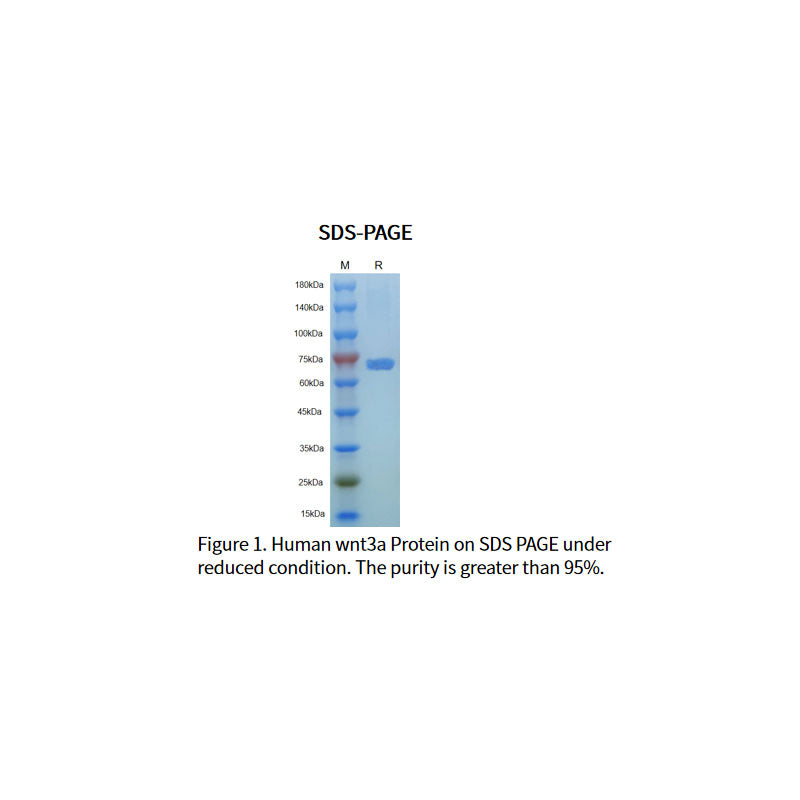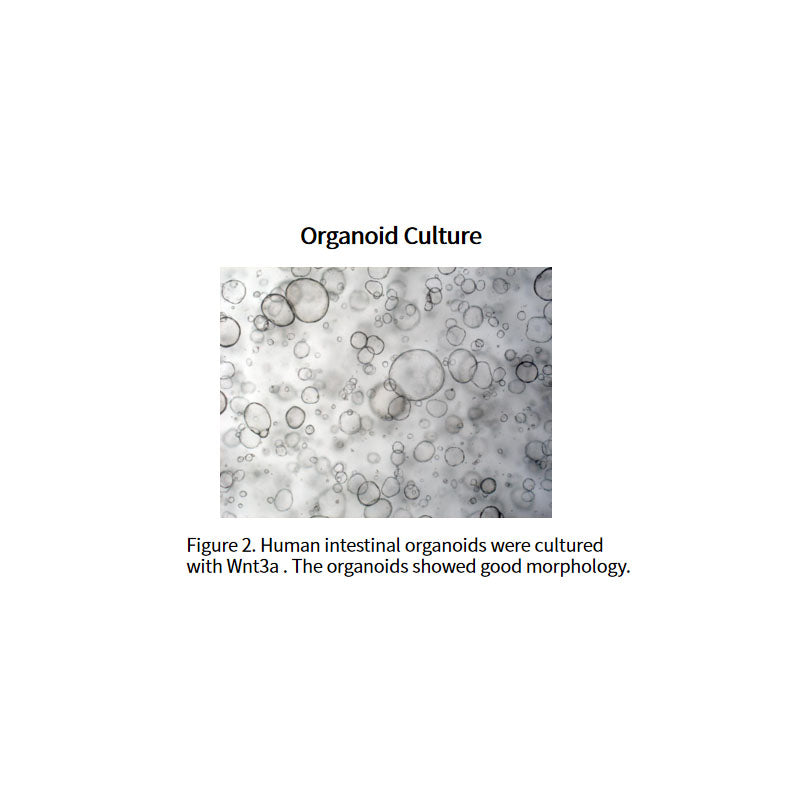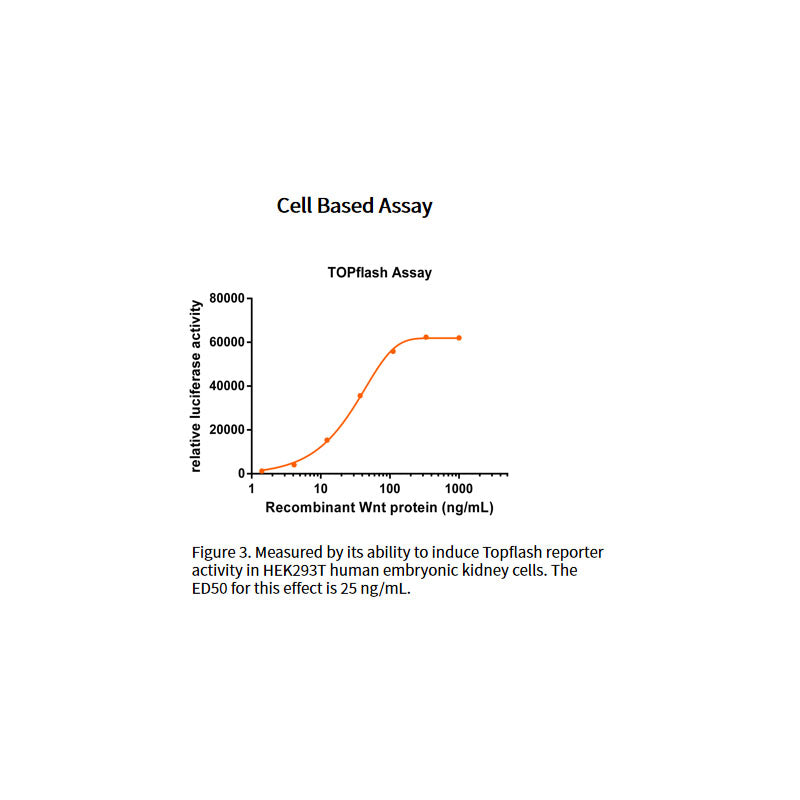Description
Wnt3a, one of Wnt family members, plays key roles in regulating pleiotropic cellular functions, including self-renewal, proliferation, differentiation, and motility. The Wnt family comprises 19 human proteins, including Wnt1, Wnt2, Wnt2b (Wnt13), Wnt3, Wnt3a, Wnt4, Wnt5a, Wnt5b, Wnt6, Wnt7a, Wnt7b, Wnt8a, Wnt8b, Wnt9a (Wnt14), Wnt9b (Wnt14b), Wnt10a, Wnt10b, Wnt11, and Wnt16. These genes encode secreted glycoproteins that are rich in cysteine. Wnts can combine with cell membrane receptors that play a critical role in autocrine regulation and/or participate in paracrine modification by binding to adjacent cell membrane receptors. The signal transduction pathway mediated by Wnt genes is called the Wnt signaling pathway. Accumulating evidence has suggested that Wnt3a promotes or suppresses tumor progression via the canonical Wnt signaling pathway depending on cancer type. In addition, the roles of Wnt3a signaling can be inhibited by multiple proteins or chemicals. Human Wnt-3a shares 96% aa identity with mouse mouse, bovine and canine Wnt-3a, and 89%, 86% and 84% aa identity with chicken, Xenopus and zebrafish Wnt-3a, respectively. It also shares 87% aa identity with Wnt3. During embryonic development, Wnt-3a is necessary for proper development of the hippocampus, anterior-posterior patterning, somite development, and tailbud formation. Wnt-3a also promotes self-renewal of hematopoietic stem cells, neural stem cells, and embryonic stem cells.
Product Properties
|
Synonyms |
Wnt Surrogate;Wnt Surrogate-Fc Fusion Protein; |
|
|
|
|
GeneID |
89780 |
|
Source |
HEK293 cells-derived Human wnt-3a, Ser19-Lys352. |
|
Molecular Weight |
Approximately 63.3 kDa. |
|
AA Sequence |
SY PIWWSLAVGP QYSSLGSQPI LCASIPGLVP KQLRFCRNYV EIMPSVAEGI KIGIQECQHQ FRGRRWNCTT VHDSLAIFGP VLDKATRESA FVHAIASAGV AFAVTRSCAE GTAAICGCSS RHQGSPGKGW KWGGCSEDIE FGGMVSREFA DARENRPDAR SAMNRHNNEA GRQAIASHMH LKCKCHGLSG SCEVKTCWWS QPDFRAIGDF LKDKYDSASE MVVEKHRESR GWVETLRPRY TYFKVPTERD LVYYEASPNF CEPNPETGSF GTRDRTCNVS SHGIDGCDLL CCGRGHNARA ERRREKCRCV FHWCCYVSCQ ECTRVYDVHT CK |
|
Tag |
Fc |
|
Purity |
> 75% as determined by SDS-PAGE. |
|
Activity |
Measured by its ability to induce Topflash reporter activity in HEK293T human embryonic kidney cells. The ED50 for this effect is 25 ng/mL. |
|
Endotoxin |
< 0.1 EU per 1μg of the protein by the LAL method. |
|
Formulation |
Lyophilized from a 0.2 µm filtered concentrated solution in PBS. |
|
Reconstitution |
We recommend that this vial be briefly centrifuged prior to opening to bring the contents to the bottom. Reconstitute in sterile distilled water to a concentration of 0.1-1.0 mg/mL. Stock solutions should be apportioned into working aliquots and stored at ≤ -20°C. Further dilutions should be made in appropriate buffered solutions. |
Shipping and Storage
The products are shipped with ice pack and can be stored at -80 ℃ for 1 year.
Recommend to aliquot the protein into smaller quantities when first used and avoid repeated freeze-thaw cycles.
Cautions
1.Avoid repeated freeze-thaw cycles.
2.For your safety and health, please wear lab coats and disposable gloves for operation.
3.For research use only!
Manual
Payment & Security
Your payment information is processed securely. We do not store credit card details nor have access to your credit card information.
Inquiry
You may also like
FAQ
The product is for research purposes only and is not intended for therapeutic or diagnostic use in humans or animals. Products and content are protected by patents, trademarks, and copyrights owned by Yeasen Biotechnology. Trademark symbols indicate the country of origin, not necessarily registration in all regions.
Certain applications may require additional third-party intellectual property rights.
Yeasen is dedicated to ethical science, believing our research should address critical questions while ensuring safety and ethical standards.



